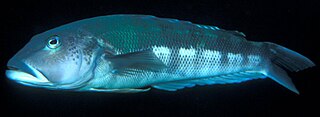
The New Zealand blue cod is a temperate marine fish of the family Pinguipedidae. It is also known variously as Boston blue cod, New Zealand cod, sand perch, or its Māori names rāwaru, pākirikiri and patutuki.
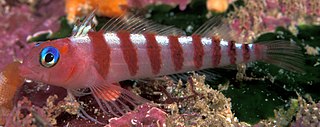
The blue-eyed triplefin, Notoclinops segmentatus, is a fish in the genus Notoclinops, commonly found around the North Island of New Zealand from depths of a metre to about 30 m, most common in reef areas of broken rock. Its length is between 3 and 6 cm and it is easily distinguished from other small fish by its iridescent blue eyes which give its name. There are nine red vertical bars running right round the body, and an orange tinge to the back and head.
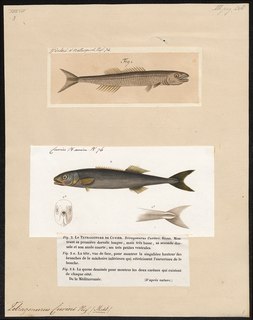
The smalleye squaretail, Tetragonurus cuvieri, is a squaretail of the genus Tetragonurus found in all tropical and temperate oceans of the world, at depths up to 800 m. Its length is 20 to 70 cm.

The black ruff is a medusafish, the only member of the genus Centrolophus. It is a bathypelagic fish found in all tropical and temperate oceans at depths of 50 to 1,000 m. Its length is typically up to 60 cm (24 in), but it may reach 150 cm (60 in). Other common names include rudderfish and blackfish.

The New Zealand smooth skate is a skate of the genus Dipturus, found around New Zealand at depths between 15 and 1,300 m.

Krøyer's deep sea angler fish is a species of fish in the family Ceratiidae, the sea devils. This deep-sea anglerfish is found in all oceans, at depths of 0 to 4,400 m, but mainly between 400 and 2,000 m. Females typically are 77 cm (2.53 ft) long, but can reach 120 cm (3.9 ft). The much smaller males only reach 16 cm (6.3 in) and they are symbiotic, as they attach themselves to a female.
The rudis rattail, Coryphaenoides rudis, is a fish of the family Macrouridae, found around the world in tropical and subtropical oceans, at depths between 600 and 2,300 m. Its length is between 30 and 40 cm, although FishBase gives lengths of up to 1.1 m.

The southern blue whiting is a codfish of the genus Micromesistius, found in the southern oceans with temperatures between 3 and 7 °C, at depths of 50 to 900 m. Its length is commonly between 30 and 60 cm, with a maximum length of 90 cm. Maximum weight is at least 1350 g.

The greenback horse mackerel or greenback scad is a species of jack in the family Carangidae, found around western and southern Australia, and around New Zealand, from the surface to depths of 460 m. Its length is up to 64 cm.

The toadstool groper, also known as the Pacific rockcod, Pacific perch, Strawberry cod and whitespotted sea bass is a sea bass of the subfamily Anthiinae of the family Serranidae, is found in the southern Pacific Ocean. Its length is between 20 and 40 cm.
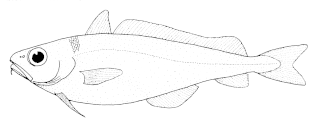
Mora moro, the common mora, is a deep-sea fish, the only species in the genus Mora. It is found worldwide in temperate seas, at depths of between 300 and 2,500 m. Its length is up to about 80 cm. Other names in English include goodly-eyed cod, googly-eyed cod, and ribaldo.
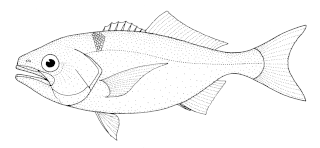
Hyperoglyphe antarctica, the Antarctic butterfish, bluenose warehou, deepsea trevally, blue eye trevalla, blue-eye cod, bluenose sea bass, or deep sea trevalla, is a medusafish of the family Centrolophidae found in all the southern oceans, at depths of between 40 and 1,500 m. Its length is up to about 140 cm, with a maximum published weight of 60 kg.
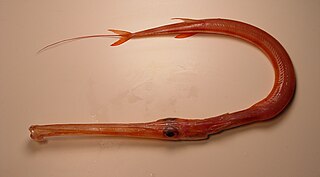
The red cornetfish, also known as the rough flutemouth, is a cornetfish of the family Fistulariidae, found in subtropical and tropical oceans worldwide, at depths between 10 m (33 ft) and 200 metres (660 ft). They are up to 2 m (6.6 ft) in length but rarely exceed 1 m (3.3 ft).

The saddletail grouper, also known as black cod or black rock-cod in Australia, and as saddle-tailed grouper or spotted black grouper in New Zealand, is a large marine fish of the family Serranidae. It is found off the coastline of southeastern Australia and northern New Zealand, generally inhabiting near-shore rock and coral reefs at depths down to 50 metres. Its main range comprises the southeast coastline of Australia, in the state of New South Wales; New Zealand populations are suspected to be nonbreeding, so are a result of drifting larvae. However, spawning aggregations have been recorded off northern New Zealand.

The longnose velvet dogfish is a sleeper shark of the family Somniosidae, found circumglobally in southern hemisphere subtropical seas, at depths of between 230 and 1,500 m. It reaches a length of 130 cm.
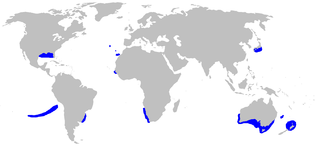
The roughskin dogfish is a sleeper shark of the family Somniosidae, found around the world on continental shelves in tropical, subtropical and temperate seas, at depths of between 100 and 1,500 m. It reaches a length of 121 cm.

The pink frogmouth or redeye, Chaunax pictus, is a sea toad of the family Chaunacidae, found around the world on continental shelves in tropical and temperate waters, at depths of between 200 and 660 m. Its length is up to 40 cm. It can be distinguish from present species with a black, deeply concave illicial cavity, and an esca that is black anterodosally and pale or white posteroventrally.

The orange bellowsfish is a species of fish of the family Macroramphosidae, found around South America, at depths of 150 to 580 m. Its length is up to 18 cm (7.1 in).
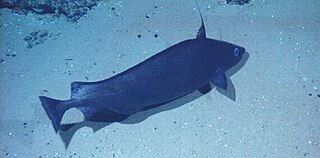
Antimora is a genus of morid cods.

The North Atlantic codling is a species of fish in the family Moridae.




















